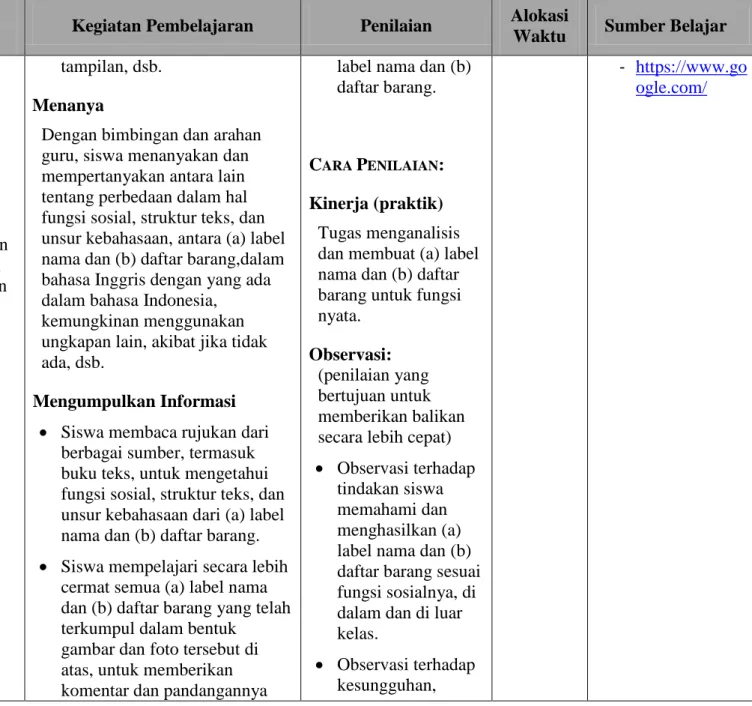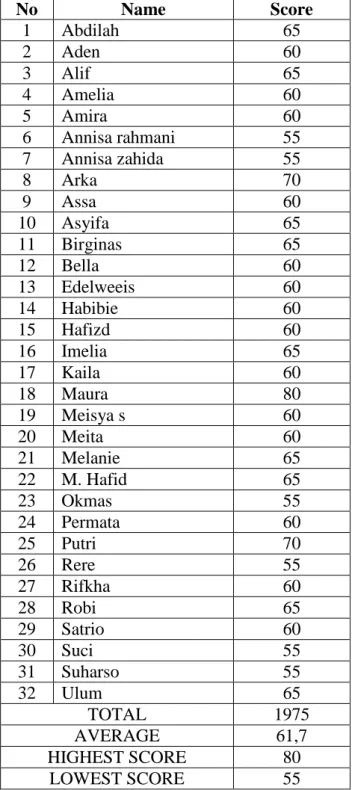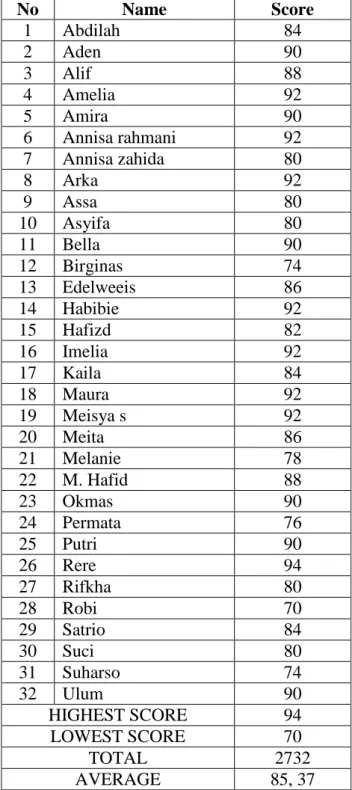The researcher concluded that there was a significant improvement of the use of flashcard on the vocabulary mastery in the seventh grade of MTs N 1 Lampung Timur. This research-based thesis titled "Utilizing Flashcard as Media to Enhance Students' Vocabulary Mastery at the Seventh Grade of MTS N 1 Lampung Timur."
Background of the Study
The result of students' vocabulary mastery pre-survey score of seventh graders in MTs N 1, Lampung Timur No grade explanation Frequency percentage. It is clear that the vocabulary of seventh grade students in MTs N 1 still lacks vocabulary.
Problem Identification
Other teaching cases in teaching English in the seventh grade of MTs N 1 Lampung Timur, such as (1) students have difficulty in memorizing vocabulary (2) students feel bored in memorizing vocabulary (3) student (4) Many students lack vocabulary. Based on the above explanations, it is to create inspiration for the researcher to do a classroom action research, because the researcher wants to know how far flashcards can improve vocabulary mastery, so the researcher would like to conduct a research titled, "Using Flashcards to Improve Students" .
Limitation of the Problems
Problem Formulation
The Objective and Benefit of the Research 1. Objective of the Research
Benefit of the Research
This research can be used as information, especially for the process of teaching vocabulary through flashcards. The result of the research can be used in comparison with other researchers for future research.
- The Kinds of Vocabulary Mastery
- Word Categories in Vocabulary
- The Importance of Vocabulary
- The Techniques in Teaching Vocabulary
Johnson gives a deep explanation that vocabulary classified into four types, namely listening, speaking, reading and writing vocabulary.9 He explains them one by one in paragraphs continuously. Thornbury points out that knowing how words are described and categorized can help us understand the decisions that curriculum planners, material writers and teachers make when it comes to teaching vocabulary.11 There are aspects to vocabulary:.
The Concept of Flashcard
Definition of Flashcard
Flashcard can be used for consolidating vocabulary, practicing structure and word order, or for a variety of games.19. 18 Spencer Kagan and Migual Kagan, Kagan Comparative Learning, (San Clemente, Kagan Publishing, 2013), p. 1) They can be used to highlight a structure or function.
The Advantages of Flashcard
Depending on the type of card, we can conclude that the picture, word or illustration on the card should be attractive, very entertaining and large enough for the whole class to see, as this will keep the students interested.
The Procedures of Teach Vocabulary by Flashcard
Still on cards marked B, C, and D have the word spoon, pot, and light, which means "sendok, peiruk, and lilin." So among the players who have the picture cards "sendok, periuk and lilin", the player without turn can degrade the card immediately.23. The key to using flash cards is to look at the word or definition on one side and test yourself to see if you can remember the answer written on the other side.
Action Hypothesis
Some of these flashcards are designed to improve your English, while others can help you learn a new language in its entirety. This way, you can improve your knowledge of the vocabulary on the list and improve your general vocabulary.
Object of the Research
Fifth, action research can create a small community of research-oriented individuals within the school itself.2. 3 Anne Burns, Doing Action Research in English Language Teaching: A Guide for Practitioners, (New York: Routledge, 2010), p.
Research Procedure
In this observation, the researcher observed the students' activity in teaching learning process and recording using note. So in research, the researcher must play the roles of observer and object of research. The researcher reflected cycle I and observed the actions to find the problems with the learning process of the activities, to use flashcard in the teaching of vocabulary.
In this step, the researcher observed the process of teaching learning by using format of observation to collect the data in action plan II. d) Reflect.
Data Collection Technique
Test
Documentation
Observation
Data Analysis Method
Indicator of Success
Result of the Research
Description of the Research Location
The Description of Research Data
Action and Learning at Pre-Test
After praying as a teacher, the researcher greeted the students and did the usual activity in each meeting and informed the last material given in the last meeting. When all the students were ready to have topic, the researcher introduced herself to students and the researcher asked the students to introduce themselves. From the table above it can be seen that the highest score is 80 and the lowest is 55.
The number of students scoring 70 and above is 3 students and lower than 70 is 29 students. The result from the student vocabulary scoreboard, only 3 students passed the SMR (Standard Minimum Requirement). Analyzing the pretest result, the researcher made a plan to make a cycle to solve the students' vocabulary problem.
Cycle 1
Shirt said the researcher and the students repeated it, knife she said and the students repeated it, etc. After the students repeated it two or more times, the researcher asked the students: "Do you remember the words of the example of the noun noun?". The students are just silent. "apakah kalian sudah hafal kosa kata tentang macam-macam kata benda?". "miss sudah!" the students answered together.
After it was finished, the researcher asked the students to close their game and book, the researcher gave questions to the students one by one by showing the flash cards. And the time was over, the researcher asked the students to learn and memorize about the new vocabulary they got at home and the learning will continue the next meeting. The researcher started the lesson in class by praying to greet the students, checking the attendance list and asking the students' condition.
The researcher reviewed explanation of the material of noun and about the vocabulary memorized. From the result of cycle I it showed that there was an improvement of the result at pre-test and post-test 1. The students were sufficiently interested in learning process although the condition of learning process was still uncontrolled.
Cycle II
Then the researcher showed flashcards consisting of an example verb and the researcher said it in English and asked the students to repeat it. The researcher said look, they said look again they said wash, walk, listen, try, run and the students repeated it. Then the researcher showed flashcards consisting of verb and said it in English and the students repeated it.
The researcher divided the students into a group and the students began to learn vocabulary using a flashcard. The researcher thought that an oral test was better than a written test for knowing students' vocabulary skills. After the students finished the post-test, the researcher said to the student years.
In this session the researcher got the results of the students' . post-test 2 in cycle II. The students listened to the researcher's explanation and did not make noise in the learning activity.
Interpretation
Students’ Learning Activities data
The researcher should motivate students to always bring a dictionary, read and memorize about English (vocabulary) and dialogue with a friend to express their idea. The result of the students' activities has improved from cycle 1 to cycle 2. The students who come to each meeting to get material and answer teachers' questions are constant.
From cycle 1, the students must come in every meeting to get the material was 32 and cycle 2 was 32. Based on the data above, it can be concluded that students felt comfortable and active with the learning process because most students had good increase in learning activities when guidance was applied in the learning process from cycle 1 to cycle 2.
Students’ Result Cycle 1
From the mean score of pre-test and post-test 1 above, it can be seen that there has been an improvement in students' vocabulary mastery.
Students’ Result Cycle 2
From the average score after test 1 and after test 2 above, it can be seen that there was an improvement in students' vocabulary mastery. Comparison of students' average score in pre-exam, post-exam 1 and post-exam 2. The table above shows that there was an improvement from post-exam 1 to post-exam 2.
The students can reach the target, the target is that 80% of the students get grade ≥70 and they can understand the material and can speak English better than before. Considering all the data collected in the classroom action research, the researcher got some research conclusions and some suggestions in the research result.
Conclusion
Suggestions
Mengamati tindakan siswa menggunakan bahasa Inggris untuk menyebutkan (a) nama hari, (b) bulan, (c) nama waktu hari, (d) waktu dalam bentuk angka, (e) tanggal, dan (e) tahun yang muncul. Siswa mendiskusikan kesulitan yang mereka alami menggunakan bahasa Inggris dalam mengucapkan dan menanyakan (a) nama hari, (b) bulan, (c) nama waktu hari, (d) waktu dalam bentuk angka, (e) tanggal, dan (e) tahun dan tuliskan dalam buku harian pelajaran sederhana dalam bahasa Indonesia. Observasi tindakan siswa menggunakan bahasa Inggris untuk menyebutkan dan menanyakan nama dan nomor hewan, benda, dan bangunan umum saat muncul.
Siswa mendiskusikan masalah yang mereka hadapi dalam menggunakan bahasa Inggris untuk menyebutkan dan mencari nama dan nomor hewan, benda dan bangunan umum dan menuliskannya dalam jurnal belajar sederhana dalam bahasa Indonesia. Dengan bimbingan dan arahan guru, siswa mengidentifikasi ciri-ciri (fungsi sosial, struktur teks, dan unsur kebahasaan) interaksi dengan menyebutkan dan menanyakan tentang ciri-ciri orang, binatang, benda. Mengamati tindakan siswa menggunakan bahasa Inggris untuk menyebutkan dan menanyakan tentang ciri-ciri orang, hewan, benda, saat ada kesempatan, di dalam dan di luar kelas.
Siswa mendiskusikan kesulitan yang dihadapi dalam menggunakan bahasa Inggris untuk menyebutkan dan menanyakan tentang sifat orang. tuliskan dalam jurnal belajar sederhana dalam bahasa Indonesia. Dengan bimbingan dan arahan guru, siswa mengidentifikasi ciri-ciri (fungsi sosial, struktur teks, dan unsur kebahasaan) interaksi dengan menyebutkan dan menanyakan tentang perilaku/tindakan/fungsi orang, hewan, benda. Siswa membandingkan ungkapan penamaan dan perilaku bertanya. tindakan/fungsi orang, hewan, benda yang dikumpulkan dari berbagai sumber tersebut di atas.
Mengamati tindakan siswa menggunakan bahasa Inggris untuk menyebutkan dan mencari deskripsi orang, hewan, benda, ketika ada kesempatan, di dalam dan di luar ruangan.

Write in the letter of the opposite on the right that matches the word on the left
Write in the opposite letter on the right that matches the word on the left.
Write in the letter of the meaning (Indonesian Language) on the right that matches the word on the left
Choose the correct answer by crossing a,b,c or d!
Please to fill the blank in the paper!

